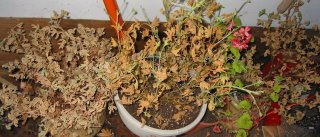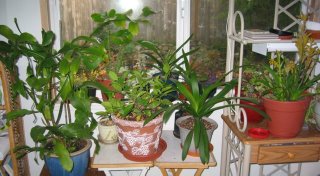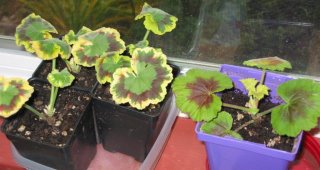
Today was a day of rest - in other words, some puttering.
This is the
opuntia rufida that I alluded to in an earlier ramblimg.
Pruned about 15 rose bushes, to about 18 inches. Removed old canes, tried to direct new growth outwards. Aim was also toward renewal - remove older, decrepit canes and small, weak-appearing canes, and leave the stout, younger canes. Despite some of the garden books now directing us to leave them taller, I think that too much blackspot can overwinter on older canes.
Looked at a couple of rose books. There is some temptation, now, to add a coujple of English (David Austin) roses, such as
Shakespeaare or
Fair Bianca. Must restrain myself - not much place to put them. Maybe if I bought them as small, cutting-grown plants from
Heirloom Roses, they will take a few years to reach a good size, then be move to replace a poor performer? On the other hand, some of the David Austin Roses have not performed well in my garden (and some have been very gratifying) - maybe I should restrain myself. In this garden: Tamora (excellent), Symphony (OK), Galmis Castle (poor, few, small, not so fragrant blossoms), Jayne Austin (OK, very fragrant, sparse small flowers on large bush), Evelyn (OK, slow to get started, still quite small after 2 years, beautiful large fragrant flowers), Bibi Maizoon (poor, after 2 years, only a few flowers, those balled up and became moldy), Happy Child (good, slow to get started - cutting grown- but the blossoms are beautiful, not much problem with disease, and very fragrant).
 Anigozanthos
Anigozanthos, looking frail but has survived the shortest Winter days, and now might make it to Spring in the South Window. It tells me when it needs water, by wilting, then I give it some and it revivies. The goal is survival, not gfrowth, so it is watered minimally. So far this experiment with
overwintering Anigozanthos is proceeding OK.
Notable garden news:
honeybee disaster. Without them to pollinate, the fruit crops may decline. Hopefully the
Orchard Mason bees will not be affected and will fill in, in commercial orchards and in the home garden.
 This Anigozanthos did well this year, blooming most of the summer, and proved to be tolerant of sporadic watering. The yellow variety (not pictured) has green leaves but didn't produce a single flower this summer. Does that mean it will be a winter bloomer?
This Anigozanthos did well this year, blooming most of the summer, and proved to be tolerant of sporadic watering. The yellow variety (not pictured) has green leaves but didn't produce a single flower this summer. Does that mean it will be a winter bloomer?























